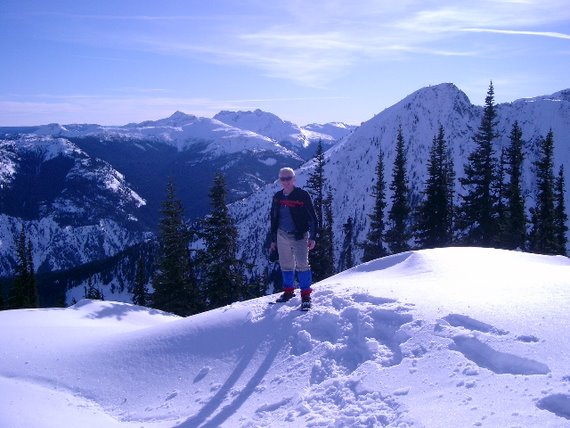Saturday, December 27, 2008
revive this blog?
Well, its nearly the end of 2008 and I think this is the only post I've made this year but a lot has happened. I spent 3 months in Haimen, Jiangsu Province, teaching English and getting the program up and running for CCEA Canada-China Education Association. You can see more about that here. I then came back to Canada, spent a good part of the summer camping in Alberta and B.C. and returned to China for 2 weeks in late August and early September to see the startup of the school year with the next group of 4 teachers. I am going back over in February 2009 with 6 more teachers and will be opening another school in Nantong. With luck, we will be able to open a third school soon in Hunan province as well.
Friday, December 21, 2007
A Chance Meeting with Bethune

The reputation of Norman Bethune is enormous. If fame can be measured by name recognition, like the concept of branding, then Bethune ranks in the top tier. Last July I participated in a unique Sino-Canadian tribute to Bethune in the thriving industrial city of Shijiazhuang where the Martyr’s Memorial features the Canadian doctor who found his calling at the side of ordinary Chinese men and women in the struggle against fascism. Mao Zedung’s essay about Bethune (紀念白求恩) and his spirit of selflessness, is required reading by all Chinese students. To say that Bethune is respected or revered in China is not an overstatement. This fact was demonstrated to me a few months later in a chance meeting with a calligrapher in the Shaanxi city of Xi’an, ancient capital of eleven dynasties and now renowned for the nearby eighth wonder of the world, the Terracotta Warriors.
There is much more to Xi’an than the self-aggrandizing memorial of a Qin emperor’s place in history. Xi’an is the ancient capital of China, origin of the Silk Road, home to eleven universities, site of the best preserved ancient city wall in China, home to a diverse and cosmopolitan population and the location of a unique collection of stone tablets marked with ancient texts carved into the stone preserving the form of the old characters. The Xi’an Beilin Museum is a calligrapher’s primary source for study of not only the text but also the form of calligraphy itself. Clear examples of different styles of calligraphy like ‘clerical script’ (Lishu style), ‘running style’(Xingshu) and ‘grass script’ (Caoshu) can be studied by experts. Rubbings are carefully made from select tablets for wider study or for the tourist appetite for a unique souvenir.
Our particular memory occurred in an unusually different manner while strolling amongst the tall black steles (stone tablets) of the museum. James, Berd and I were lagging behind our tour leader and the others in our small group in the late November afternoon, enjoying the tranquility of the monastic-like setting, which actually is an old Confucian temple complex. A scholarly young man on his way somewhere hurried past us and stopped abruptly, frozen like the words carved in the stone tablets. His gaze was fixed on Berd. He said something in mandarin to James and I picked out the name "Bai Qiu-en" (白求恩), Bethune pronounced phonetically in putonghua, the language of the common people.
The young man was a student of calligraphy and an expert in Mao style, a form of Caoshu script. He continued to gaze at Berd, exchanging a dialogue with James in an excited pitch. He was carrying a sample of his work and wanted to show us. He unrolled the scroll and James began reading it aloud, exclaiming ‘This is a poem by Chairman Mao. I know this. Its about every Chinese going to the Great Wall’. The calligrapher grinned with pleasure at James’ recognition of his work as I took a photograph of him with Berd holding the unrolled scroll. He then turned to Berd and gestured while saying, through James as the translator of his excitement in this chance encounter that he wanted to give his work to ‘Bai Qiu-en’ in recognition of the great man. He described how he had a very large portrait poster of Bethune hung in his home to remind him daily of the great man. Berd looked just like him he said. Next he searched through his satchel and pulled out another scroll, this time explaining that it was his mission to collect ten thousand signatures to present to the Beijing Olympics representing the contribution of calligraphers to the historic games. All three of us signed our names, joining the already long scroll of signatures. Again he went into his bag and searched out a blank page upon which he scribed there on the spot, another well-known poem, again from Mao’s opus, commending students to ‘Study, Study, Learn, Learn’. This he gave to me but not until it was stamped with three different chops or seals authenticating it as his work. Again he returned to his bags for another blank page and with perfect spacing, writing in vertical columns, scribed another famous work of the Great Helmsman. This he gave to James. A small token reciprocated this magnificent gesture of friendship and we parted ways in the soft late afternoon light within the walls of the old museum.
Labels:
Beilin Museum,
calligraphy,
Forest of Tablets,
Norman Bethune,
Xi'an
Sunday, September 16, 2007
Tuesday, August 21, 2007
Shanghai
 |
| Yu yuan garden |
The travel day from Chengdu began with a visit to the Panda Research Station. The loveable bears were feeding on bamboo leaves and shoots in the rain. There were many groups visiting at once so it was crowded. The red Pandas were surprisingly like raccoons, to which they are apparently related. Jennifer had her grade ones do research on pandas and knew this. The flight to Shanghai was two and a half hours and the drive in from Pudong International was another hour. After installing everyone in the hotel the group bussed out to a restaurant for dinner. At the conclusion of our meal I had to go around to each table and draw their attention to the staff that were all lined up waiting for us to leave. I guess we were relaxing into an after-dinner stupor and no one noticed the time. The staff wanted to go home.
It rains everyday in the summer in Shanghai and it is very hot by August. The temperature reaches 39 or 40 degrees Centigrade and the humidity is extreme. We visited Yu Yuan Garden in this extreme warmth and enjoyed the tranquil charm although pressed by our own large group numbers and numerous other groups, all seeking to share some piece of atmosphere in this special place. I am not sure whether it is private or publicly owned after our guide’s explanation. Peter, our guide, is very good and tells us bout life in Shanghai and China. He has a daughter in school and pays four hundred Yuen a month for private English lessons. English is taught from kindergarten but extra lessons are often desired as the language is deemed essential for business and progressing in the opening up to the world policy of present day China.
Prior to visiting the gardens we stopped as a silk factory and saw the silk making process. Eight strands of the hollow thread are twisted together by spinning wheel from eight cocoons that sit in warm water. The resulting thread is wound onto a spool for future processing. The lost leader in the factory is a silk duvet for the bed. We, along with most of our group, bought one.
The day concludes with a boat cruise and dinner on the Huang Po River. It is a carnival atmosphere. Temperature 36.5 degrees.
The final morning in Shanghai Jennifer and I walked from the hotel on Pudong Road to the tall buildings in the vicinity of the Pearl Tower. It was early when we went out, about 8:00 a.m. and the air, although warm and humid, was comfortable. On our return the air felt heavy and it was much warmer. By the time we reached the hotel my t-shirt was moist with perspiration. A cold mango slushy drink from the corner juice bar refreshed me. I didn’t worry about the ice being made from local water. Back home, I paid the price for a day or so.
The group assembled with luggage already taken care of and the busses departed for the Maglev station where the majority of us boarded for the seven minute, thirty four kilometer ride at 431 Km/hour. What a thrill!
Customs and security cleared and we are all ready for the long flight home. Arrival time will be 10:30 a.m. in Vancouver.
Chengdu
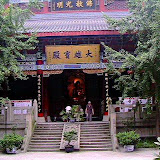 |
| Chengdu |
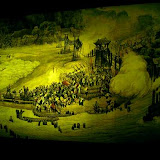 |
| Dujiangyan |
The flight from Lhasa to Chengdu is short, about one hour and forty minutes, but we had to leave the hotel early because this was the first domestic flight where each individual in our tour group was responsible for their own overweight luggage fares. This had become an issue beginning in Beijing where a number of the tour members routinely skipped planned events for shopping. Some miscommunication regarding baggage weight restrictions led to the group being over weight by more than a thousand kilograms. Tianjiao paid half the penalty and a collection took up the other half, however following flights were discussed and it was decided that a voluntary levy would cover the penalty from Xi’an to Lhasa, allowing a group check-in procedure to occur but the following two flights (Lhasa to Chengdu and Chengdu to Shanghai) would be individual. If your luggage exceeded the limit you paid your own penalty. The consequence of this is about an additional hour at the airport hence the rush on departing the hotel in Lhasa. We still had time to stop and photograph yaks in Tibet on the way to the airport.
Our arrival in Chengdu presented me with my first personal meltdown. James had arranged another government meeting and after consulting me and the other members on the Organizing Committee, decided it should be shortly after our arrival and before the Sichuan hotpot dinner. My stress came from not finding my luggage with a change of clothes suitable to a meeting with government officials. I did not want to attend wearing shorts and a t-shirt and represent myself as a member of the committee and of the newly created CCEA Canada-China Education Association. My luggage was eventually located and the meeting went ahead as planned.
The Chengdu Education Ministry already partners with a large number of American and Canadian educational institutions but the need for English language training in a city of eleven million people is substantial so the contact is still worth making for future consideration. We exchanged cards and took photos and expressed warm greetings.
After the meeting the committee members joined the rest of the tour group at the Hotpot restaurant. They had just started and I joined in the feast, dipping pork, beef, chicken, greens, and mushrooms into the two boiling broths in the centre of the table. The outer broth was less spicy and the inner broth very spicy. I got up to videotape the feast and upon my return learned that crab had been dumped into the outer broth. I am allergic to crab and carry an epipen for emergency use so I was limited to the inner, spicy pot. I enjoy spicy food and had a dozen more skewers before my tongue and lips could no longer take it. I contented myself with the sweet bun and flatbread and several glasses of Snow beer.
The following day the group departed early for the two-hour drive from Chengdu to the Dujiangyan irrigation system. The journey took us through the beautiful farming districts of the Sichuan basin. We passed rice fields and vegetable gardens and blooming Calla lilies and Hibiscus shrubs. The area closer to Chengdu is built up with a very modern business park with many high tech firms, Chinese and foreign, recently established in Sichuan. The whole area appears prosperous agriculturally and commercially. There doesn’t seem to be large numbers of heavy industries and our guides told us the heavy mist or fog was just that and not pollution. The city itself feels clean and prosperous and was delightful to walk around when we had the chance.
When we arrived at Dujiangyan the bus climbed into the hills that surround the town. When we stopped and got out we looked down at the river and irrigation works. From that vantage the immensity of the project was apparent. We descended a series of stairs to platforms where temples and shrines were dedicated to various ancestors and Buddhas. The irrigation system is two thousand years old and is an ingenious system of water diversion to feed the canal network that has been built across the Sichuan basin that lies meters below the diversion. The original construction was done in heavy bamboo logs and matted and woven surfaces that used the flow of the river to divert from the leading “fishes nose” that thrusts out into the centre of the flow of water. Everyone was thrilled with the opportunity to see this magnificent engineering feat. During the Japanese invasion the site was saved by simply opening all the barriers and flooding the town so the aircraft overhead could not find the target.
We lunched beside one of the main channels in the town and learning that Lao-Tzu, the founder of Taoism, was from the area, Joy and Jennifer decided to do a TaiChi set. Gary joined them and I filmed it.
We departed for Chengdu with a promised stop at a brocade factory. This kind of silk weaving is world famous in Chengdu. The Southern Silk Road to Burma and India originated in Chengdu. The factory is just a show place and has four weaving looms set up. We were late arriving and the staff stayed on just for us. The process is very intricate and the product stunningly beautiful. Jen and I bought several items to decorate our home or give as gifts.
On the bus our guide, affectionately dubbed ‘Harry Potter’ for his look-alike, told us about a possible evening entertainment. There is a street in Chengdu recreated in the ancient fashion, Chingli Street, and it terminates at a large teahouse that has a stage show for entertainment. The whole group decided to attend and take supper outdoors in the teahouse grounds afterward. The show was delightful, more like a variety show although it had been referred to as an ‘Opera’. One act was a knife thrower whose assistant pretends to be cowardly and selects an audience member to be the victim. He chose Stuart. It was a hilarious setup with Stuart blindfolded and no knives really being thrown. Great fun! The concluding act was the famous mask-changing act. The actors change from a white mask, signifying evil, to a red mask, signifying good and loyal, to a black mask, perhaps signifying the terror of everyone, in a flash. You cannot see the hand change the mask. It is so fast!
Sunday, August 12, 2007
Drepung, book donation, Jokhang
 |
| Drepung |
Drepung Monastery is nestled up against the mountain at the edge of Lhasa city. It is a large complex of buildings, once housing seven thousand monks. It is now home to three hundred. Pilgrims from across Tibet still come to this famous monastery to pay homage to the Buddha. The monks welcome tourists and a well-marked route through the complex helps the visitor orient to the famed contents of the chapels and assembly halls. Photographs are permitted for a small fee, usually about twenty rnb for each section of the monastery. Pilgrims carry flasks of yak butter to add to the slow burning pots that fill the air with their smoke mingled with incense. Outside, larger smoke chambers are constantly fed with juniper and cypress to create a smudge, which wafts upward carrying the prayers of the pilgrims. There is a strange balance between spirituality and power felt in this monastery. Three hundred monks instead of seven thousand represent the diminished power of Drepung Monastery. Formerly the abbot of the monastery had a voice in the operations of the city and country. Our guide, Monday, speaks of the changes since liberation. I am reminded of Quebec society and the changes of the Quiet Revolution, a shift in the balance of power from the clergy toward a secular state occurred there, too, in the ‘fifties.
The next stop in our itinerary for the day is Lhasa Beijing High School. The entire Canadian delegation was invited to donate English language books for Chinese students after James had visited Lhasa last March. At that time he met with the Principal of the school who told him that there were no authentic English language reading materials in the school. Students learned from textbooks written in China. James conceived the donation program and everyone eagerly adopted it. A total of twenty-two boxes of books, over a thousand books, were donated, some going to schools in Beijing and some to the school in Lhasa.
We arrived at the school around 11:00 a.m. in the rain. The bus turned off the approach road into the school compound where red clothed students stood shoulder to shoulder on either side of the road awaiting us. They burst into applause as the bus crawled forward between the lines of dripping, smiling, clapping students. Most of the students were seniors attending over the summer in order to improve their standing on final exams. Once inside the auditorium our delegation was seated at the front, the students behind, and the ceremony began. The Director of Education for Lhasa and the school Vice-Principal spoke while on our side; James, Sonia and I spoke. The ceremony was short and was video taped for Lhasa TV news that night. A tape will be sent to Tianjiao when we return to Vancouver.
From the school we headed to lunch with a quick stop at a local Bank of China. The clerks appeared to be overwhelmed by the busload of tourists descending upon them, including me. I was not pleased that the exchange rate for hard currency (CDN) was less than for travelers cheques. Lunch followed and then a stop to the government tourist store occupied our attention. These stores offer a guaranteed quality and authentic item in a range of Tibetan goods such as carpets, tankas, turquoise, coral and lapis lazuli jewelry. Jen and I bought a carpet and a tanka and a pair of lapis ear rings. This was our plan as far as souvenir purchases goes on this trip. The carpet was shipped to us in Surrey and arrived within ten days. It is about five feet by seven feet, hand woven and dyed with traditional colouring materials that won’t fade with time. The theme depicts a pattern of barley stukes in the field and there are small animals, some yaks and some horned sheep, that adorn the carpet. The tanka has the mark of the monk and the monastery where it was consecrated. Without this mark the tanka would be a work of art, but with the mark it is a work of religious art. In the Buddhist world this gives it a real significance.
The tour went next to the Jokhang Temple and the Barkhor district, which is the original Tibetan district in Lhasa. The Jokhang houses among other important statues, a chapel devoted to Songsten Gampo, the unifier of Tibet and its first great king. He is credited with introducing Buddhism to Tibet through his two wives, one Chinese the other Nepalese. The pilgrims converge on the temple along the phalanx of vendor’s stalls on the square in front. The pilgrims circulate within and without the temple in a clockwise direction, which is also the direction to spin a prayer wheel. Inside the Jokhang the air is heavy with incense and burning yak butter. The sacredness of the place is easy to feel almost literally as the pilgrims push their way forward to their destination. As a tourist is a courtesy to make room and not block them as they go about their mission. Many devout pilgrims have come great distances on foot and many make the prostrating movement, laying down full length every three steps. A circuit around the Barkhor is not uncommon. A journey from one’s home village, although more rare, is also not uncommon.
The Organizing Committee had to leave the Jokhang early to attend a meeting with government officials at the Lhasa city administration building. The book donation ceremony at the school had been reported and the Party Secretary, Education Director, Foreign Affairs Director the school Vice-Principal and another Director of some other department all wanted to meet us. The Party Secretary was in charge and seemed a good leader, large stature, smiling and welcoming. We talked for forty minutes about friendship, co-operation and some details of schooling issues. It is apparent that schooling is being consistently addressed in the three main cities of Tibet, Lhasa, Shigatse and Gyantse. It is less practical in the more remote areas of Tibet. It would certainly be wonderful to establish a real presence in Tibet for education. James and I discussed this back at the hotel later that evening and James suggested the possible beginning of a cash donation program to support a specific school in the name of the donors. A charity number would have to be obtained in Canada but the costs of support are very reasonable from a donor perspective. This is something to pursue back in Vancouver.
The final evening in Lhasa, Jennifer, John and I walked around the market streets that surround our hotel. The hotel is located behind the large square that lies at the foot of the Potala.
Saturday, August 11, 2007
Norbulingka, Sera Monastery and Potala
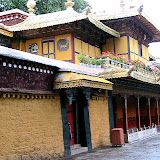 |
| Norbulingk |
The Summer Palace is now a poorly kept tourist attraction with only a few of the pavilions open to public viewing. Its origin, a special healing spring, is now not working due to an earthquake but the story is interesting. An early Dali Lama or Living Buddha, had a skin condition that was cured by the waters of a nearby spring. When the Emperor in China heard of this he had the Summer Palace built for the Dali Lama. The palace is also famous for its more recent history as the last location of the 14th Dali Lama in Tibet. His dramatic escape from the city in 1959 is recalled in the clock that stopped working at 9:00 p.m. when he departed. Today the grounds are the site of a local festival in August that lasts several days (the yogurt festival?). People set up tents and cook and eat and of course drink and visit at that time. Common people never got inside in the early days and only the nobles and high monks shared in the once beautiful gardens.
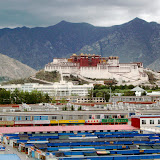 |
| Potala Palace |
After lunch the group makes its way to the Potala Palace. The number of visitors per day is now limited and group sizes cannot exceed twenty-five. We were thirteen, twenty-five and twenty-five. Many Tibetans come to Lhasa and visit the Potala Palace among other holy sites. The palace is no longer in use but monks are stationed throughout to ensure the sanctity of the place is observed. Women and men must be respectfully dressed and no photography is allowed. The visitors are limited to one hour from start to finish in the interior of the buildings. Our guide, Monday, conducted the tour with an informative explanation of each room. Tours are led in an orderly flow from the bottom up to the top and do get to see the great rooms and sacred locations of this treasured palace. The interior is dimly lit with electric lamps and one can only imagine earlier times when yak butter lamps lit this space. I cannot help but feel the deep spirituality of this place. In some rooms the three dimensional universe is represented and Monday describes how the Living Buddha is at the centre of this three dimensional universe inside the Potala Palace.
 |
| Sera Monastery |
Our final stop is the Sera Monastery, once housing seven thousand monks but now housing three hundred. Our visit is specifically to witness the debating style of these monks. Groups of monks sit together in a courtyard while one stands and declares a question to another individual monk. The questioner slaps his hand and gestures and shouts in a loud voice for an answer. The response is sometimes immediate but if it is not forthcoming or if it is wrong then the respondent is publicly derided. There is much humour in these debates but sometimes there are serious looks and other participants are relieved to not be in the hot seat.
Xi'an
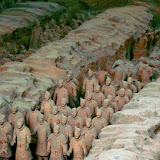 |
| Xi'an |
Xi’an is a city of universities. It is the ancient capital of China, first unified by Emperor QinShiHuangDi in 221 BC. This city was home to eleven dynasties among which the Han ruled longest and the Tang proved most prosperous. We are scheduled to attend a Tang Dynasty music and dance presentation this evening. Our hotel is inside the city wall and located in the Muslim quarter of the city. Once settled, we go to dinner at a local restaurant for a hot pot style meal. The individual small hot pots for each person are a new adventure in eating for most of us but we all enjoy the experience.
The following morning we travel by bus to the site of the Terracotta Warriors excavation. The site is enormous, covering over fifty square kilometers. We spent several hours wandering through the large excavation halls looking down into the pits of unearthed and repositioned warriors. The entire spectacle is overwhelming and leaves you in awe at the power of the individual who could command such a construction. It is of the scale of the ancient pyramids and has a similar other worldly aura to it. The excavation to date is miniscule compared to what it is estimated to be buried beneath the fields. Already it is called the Eighth Wonder, what will it be when it is fully revealed?
The evening entertainment of Tang Dynasty music and dance was like a variety show and left us well satisfied with our day. Tomorrow we fly to Tibet.
Temple of Heaven
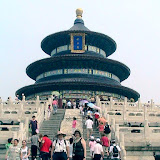 |
| Temple of Heaven |
Today is moving day, after nine days in the hotel in Beijing we are now setting out on the short stay portion of our trip. First, we will fly to Xi’an and stay for two nights, then Lhasa for three nights, Chengdu for two nights and finally Shanghai for the final two nights. It seems like a whirlwind trip but it will take us to some incredible locations and expose us to a broader range of Chinese culture and history, past and present.
The morning is one of the few free-time periods we have and Jennifer, Joy and I decide to join up with a few others and taxi over to the Temple of Heaven for a quick visit. We arrive at the South Gate entry and walk past groups of Chinese summertime visitors doing Tai Chi, sidewalk calligraphy, swing dancing and strolling about like us. It is a cheerful, relaxed morning as we make our way to the Circular Mound Altar where individuals are taking pictures of children and parents or friends standing in the centre of the universe. We make our way toward the north and the main temple but take a tree-lined path to the west for its shade. There we discover a large group of people engaged in singing. Passersby join in the songs, evidently all well known melodies to the locals. More groups of people are engaged in activities like badminton, exercises and dancing. A young woman comes up to us to invite us to visit her art school exhibition. Having visited a similar exhibit in the Forbidden City we decide to go along. The art schools apparently have access to some excellent locations such as this in order to show off their student and teacher works. We decide to purchase some of the art at the set price of 200 rnb each. The art is excellent and will be suitably framed once we get home. The destination of our morning stroll is the main temple The Hall of Prayer for Good Harvests. There we are momentarily brushed aside by a group of un-uniformed security to make way for a small delegation of military men accompanying a VIP to have a closer look at the temple. I work my way closer to the group and hear the guest of honour speaking in what sounds like Russian. They leave just as quickly as they came and an elderly man steps forward to us and says in English “The new empire is already appearing. In fifteen or twenty years or maybe fifty the world will follow the Chinese lead. The Americans won’t dare to start wars on their own.” He is eighty-five and from Poland.
We return to take our leave from the hotel and bus to the city airport where we board our flight to Xi’an. Most of the large group will go to Xi’an but some will remain in Beijing. After the short stay in Xi’an an even smaller group will go on to the other cities while the others return to Beijing and Vancouver.
Wednesday, August 08, 2007
Subscribe to:
Posts (Atom)


